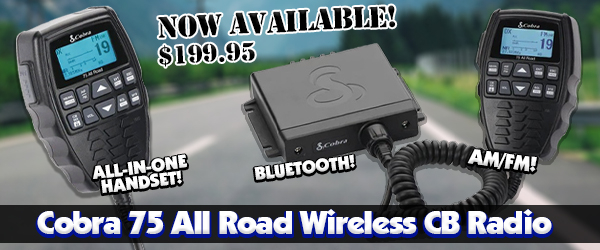
Weather channels and weather alerts are considered standard features in many makes and models of consumer FRS, GMRS and CB radios available today. Cobra, Garmin, Midland, Motorola, Olympia and Uniden all offer NOAA weather channels in many of their FRS/GMRS products, and a couple even offer them in a few models on the low end.
These are no doubt useful and potentially life saving features in portable handheld two way radios. But how do they work? How do you use NOAA weather channels on a two way radio or, for that matter, on a dedicated handheld or desktop emergency weather radio?
There are seven radio frequencies on the VHF band designated specifically for NOAA weather broadcasts. These frequencies are used by a network of transmitters across the US to broadcast weather information, warnings and alerts 24 hours a day, 7 days a week, 365 days a year. Some two way radios even have three additional weather channels, two of which are used by Canada for marine weather broadcasts. The seven NOAA frequencies are listed as follows:
- 162.400
- 162.425
- 162.450
- 162.475
- 162.500
- 162.525
- 162.550
There is no standard channel assignment for weather frequencies on two way radios. For instance, The weather frequency 162.400 MHz may be assigned to Channel 1 on one make and model radio and assigned to Channel 4 on other one. Radio manufacturers program channel assignments with weather frequencies at their discretion. While it may seem confusing, the question of which frequency is on which channel can usually be resolved by referring to the owners manual for your particular radio. The manufacturer will typically print a list or table of the weather frequency channels in the manual, along with instructions on how to access them.
The real trick is to find out what frequency is most relevant to your area of operation. That's where the National Weather Service comes in. The NOAA Weather Radio All Hazards web site provides a complete listing of all weather station broadcast frequencies in the US.
There are two ways to search for the NWS transmitter most relevant for your area. The first option is to search the NWS Nationwide Station Listing Using Broadcast Frequencies. Simply click on your state, locate the name of the area closest to you on the list, and note the call sign and its corresponding frequency. Clicking on the call sign will take you to another page with additional details about the transmitter and a geographical map with a graphic depiction of its broadcast coverage.
The second option is to go to NWR Transmitter Search, enter the name of an area or state in the search box, and click on the icon displayed on the map for information and details about the transmitter.
Once you know the frequency of the transmitter in your area, it's just a matter of locating the channel on your radio programmed to that frequency and then activating it according to the instructions in your manual. That's really all there is to it.
For an example of how to activate weather channels on a handheld walkie talkie, watch our Radio 101 video How to activate weather alerts on Motorola Talkabout MS Series radios. While the video is specific to some Motorola Talkabout FRS/GMRS radios, it may provide a general overview of how the process works on other radios as well. Consult your owner's manual for the specific steps required to activate weather channels and alerts on your make and model of radio.











Most of the time, this is overthinking the problem. 99% of the time, the one you get the best reception of will be the one that is most relevant to your location.
Canada's weather service also broadcasts weather on the same channels that NOAA uses. If you're near the border, you may be able to receive those in addition to or instead of the NOAA stations, and they may be more relevant to your location. (Just remember that the temperatures are given in Celsius.). For example, I was only able to receive the Canadian broadcasts when I visited Lubec, Maine.
Any FM or AM frequency to listen to NOAA Radio in Southern Indiana
If you read the article and click on the link to the NWR frequencies, you will find the list of NOAA weather stations for Indiana.
Is there any weather station which receives NOAA and also AM and FM? Will be the best in your product list? I would like to know